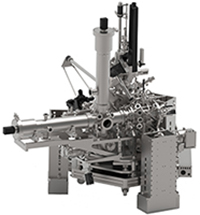3D model of the HEXTOF setup (Credits: H. Meyer, S. Gieschen (Univ. Hamburg) and D. Kutnyakhov (DESY)).
Main measurement chamber (front part) with sample stage (right), two drift tubes with retractable spin-filter (coming from back). Beam comes from front through horizontal port. Preparation chamber (behind main chamber) with vertical manipulator and load-lock (Please enlarge the figure (+) to get more information).
In the quest to gain predictive understanding of the functionality of condensed matter systems, the energy and momentum analysis of photoemitted electrons provide the most direct insights. Time-resolved photoemission in combination with the high-repetition rate of the free-electron laser FLASH at DESY enables now to probe the sub-picosecond dynamics of systems at the new versatile instrument for high energy X-ray time-of-flight (HEXTOF) measurements. In particular low-dimensional materials, molecular crystals, and quantum materials can be investigated.
HEXTOF merges three photoemission spectroscopy techniques into a single setup, namely time-resolved momentum microscopy (trMM), time-resolved X-ray photoelectron spectroscopy (trXPS), and time-resolved X-ray photoelectron diffraction (trXPD). “Traditionally, these experiments are carried out using separate instruments. However, we managed to combine all three techniques into the same instrument. The combination with pump-probe schemes of FLASH extends the available range for measurements into the sub-picosecond time domain.” explains DESY scientist Dmytro Kutnyakhov.
With this instrument the two momenta of photoelectrons transversal to the sample surface can be measured simultaneously (trMM) typically from the valence and conduction bands of materials. Furthermore, it is possible to investigate the dynamics of electronic core levels (trXPS) or momentum-resolved changes in the coherent photoelectron scattering with bulk and surface (trXPD).
The HEXTOF instrument features full-field momentum-resolved imaging and time-of-flight energy recording in the so called ‘momentum microscope’ for direct mapping of multidimensional electronic structures. An experimental energy resolution of 130 meV, a momentum resolution of 0.06 Å−1, and a system response function of 150 fs could be achieved. It includes also a sample preparation chamber and corresponding characterisation tools. The overall performance was demonstrated by investigating the carrier dynamics in a model system of layered semiconductors – tungsten diselenide (WSe2).
HEXTOF is routinely used at the PG2 beamline at FLASH for pump probe photoemission studies, as well as - in between FLASH beamtimes - with a table-top high harmonic laser source in the Center for Free-Electron Laser Science (CFEL) to perform either sample pre-characterisation before FLASH beamtimes or independent research activities.
Original Publication:
Time- and momentum-resolved photoemission studies using time-of-flight momentum microscopy at a free-electron laser; by D. Kutnyakhov, R. P. Xian, M. Dendzik, M. Heber, F. Pressacco, S. Y. Agustsson, L. Wenthaus, H. Meyer, S. Gieschen, G. Mercurio, A. Benz, K. Bühlman, S. Däster, R. Gort, D. Curcio, K. Volckaert, M. Bianchi, C. Sanders, J. A.Miwa, S. Ulstrup, A. Oelsner, C. Tusche, Y.-J. Chen, D. Vasilyev, K. Medjanik, G. Brenner, S. Dziarzhytski, H. Redlin, B. Manschwetus, S.u Dong, J. Hauer, L. Rettig, F. Diekmann, K. Rossnagel, J. Demsar, H. Elmers, P. Hofmann, R. Ernstorfer, G. Schönhense, Y. Acremann, and W. Wurth; Review of Scientific Instruments, 2020; DOI; http://doi.org/10.1063/1.5118777








